In the intricate tapestry of nature, few elements are as captivating and overlooked as spores. These minute reproductive units are not merely passive byproducts of certain life forms; they are ingenious survival mechanisms that exhibit extraordinary capabilities. In this exploration of super spores, we delve into their biology, significance, and the remarkable adaptations that allow them to thrive in a variety of environments.
What Are Spores?
Spores are typically unicellular structures produced by certain plants, fungi, and bacteria as a means of reproduction. Unlike seeds, which require specific conditions to germinate, spores are designed for resilience. They serve as a form of asexual reproduction, allowing organisms to propagate efficiently without the need for fertilization. Depending on their type, spores can be adapted for both distress and dispersal, showcasing the clever strategies of nature in a miniature form.
The Different Types of Spores
There are numerous types of spores, each uniquely adapted to their respective organisms and environments:
-
Fungal Spores: Produced by fungi, these spores can remain dormant for long periods, allowing them to survive extreme conditions. There are several types, such as conidia and basidiospores, which differ in their structure and method of dispersal.
-
Plant Spores: In non-flowering plants such as ferns, spores are critical for reproduction. These spores are often released into the wind, enabling them to travel over great distances before germinating under favorable conditions.
-
Bacterial Spores: Certain bacteria form endospores, which are highly resilient and can withstand extreme heat, desiccation, and radiation. This unique survival mechanism allows them to endure unfavorable environments until conditions improve.
The Superpower of Dormancy
One of the most fascinating aspects of spores is their ability to enter a dormant state. This dormancy is a crucial evolutionary trait that enhances survival. Spores can withstand harsh conditions such as drought, extreme temperatures, and high radiation levels—conditions that would be lethal to many other living organisms. When environmental factors become more favorable, spores can reactivate and resume growth, showcasing an elegant balance between life and stillness.
Dispersal Mechanisms
The journey of a spore often begins with an elaborate dispersal mechanism. Fungal spores, for example, can be dispersed by wind, water, or animals. Some fungi produce lightweight spores that can float through the air, while others may use sticky surfaces to attach to animal fur or feathers. Plants utilize wind and water for far-reaching dispersal, ensuring their genetic legacy is spread across various habitats. This remarkable adaptability allows spores to find niches in ecosystems ranging from deserts to wetlands.
Ecological Importance
Spores play a vital role in various ecological processes. They contribute to nutrient cycling by decomposing organic matter, serving as a food source for microorganisms, and facilitating the establishment of diverse plant communities. In many ecosystems, such as forests and grasslands, spores help maintain the health and balance of the habitat by promoting biodiversity and resilience.
Conclusion
In summary, super spores are often underestimated, yet they are powerful agents of survival and propagation in the natural world. From their versatile reproductive strategies to their adaptable dormancy, spores embody the essence of resilience in nature. As we continue to explore and understand these tiny marvels, we gain a greater appreciation for the complexities and wonders of life on Earth. Whether through their quiet endurance during harsh conditions or their remarkable dispersal tactics, spores remind us that even the smallest components of the ecosystem play a crucial role in maintaining the balance of life.
Ready to get in the game and start making money on Pump.fun? DogWif Tools is the #1 memecoin sniper tool for becoming a Pump.fun millionaire. Get DogWif Tools today and become a memecoin dev!








